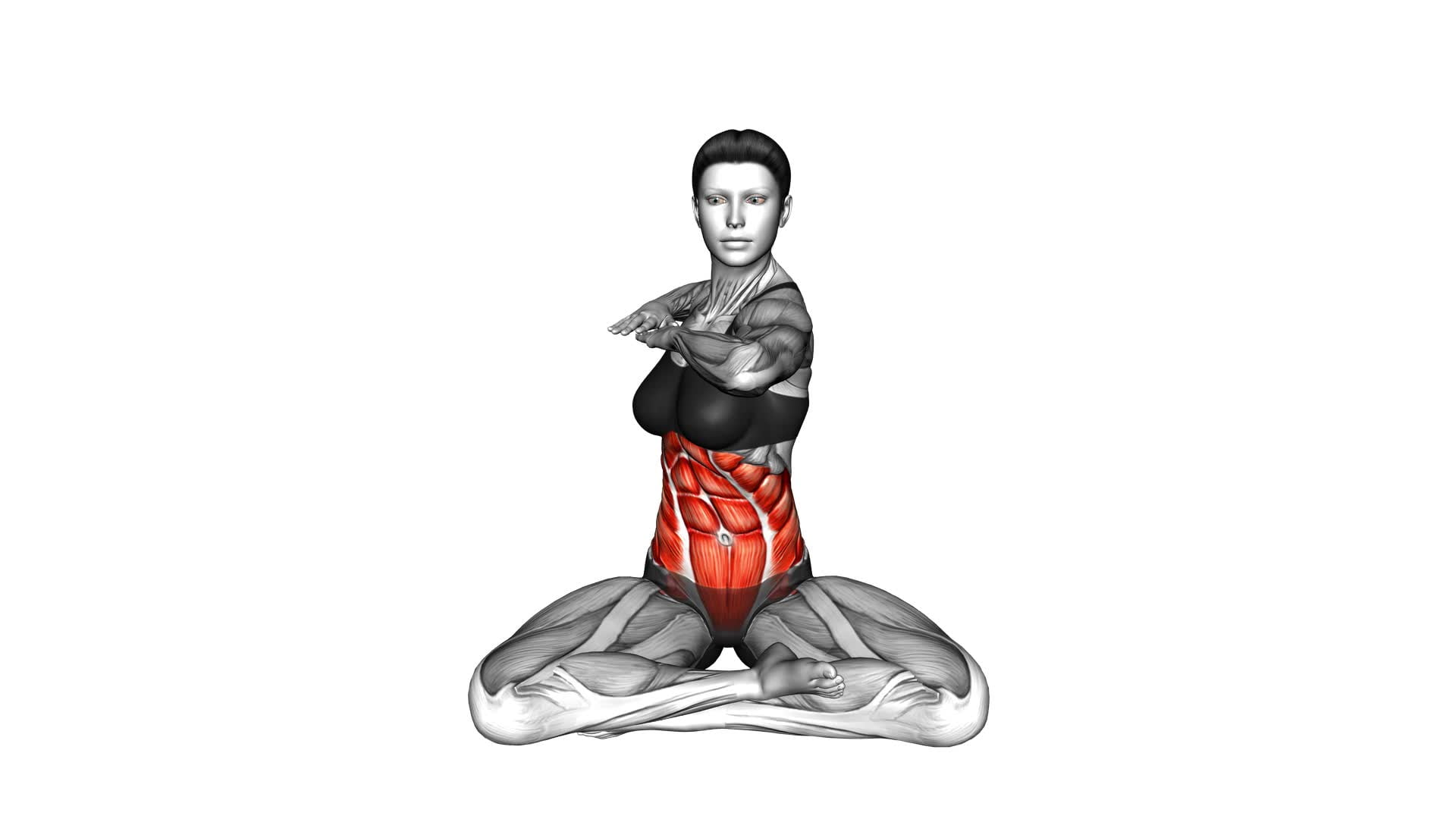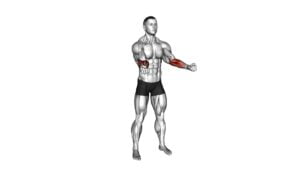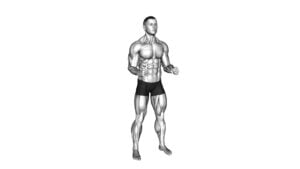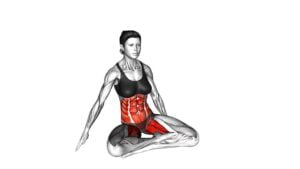Sitting Core Tight Rotation (female) – Video Exercise Guide & Tips

Get ready to strengthen your core and improve your rotational stability with Sitting Core Tight Rotation! This video exercise guide is tailored specifically for females, providing you with detailed instructions and tips to ensure proper form.
Watch This Exercise Video
By contracting your core muscles and engaging in this exercise, you'll build strength and stability in your midsection. Say goodbye to common mistakes and hello to an effective workout.
Let's maximize your results and achieve those fitness goals!
Key Takeaways
- Sitting core tight rotation strengthens and tones abdominal muscles.
- Engaging core muscles stabilizes the spine and supports movements.
- Neglecting core engagement can lead to strain or injury.
- Proper form, breathing technique, and body alignment are crucial for maximizing the effectiveness of sitting core tight rotation.
Benefits of Sitting Core Tight Rotation
One major benefit of incorporating the sitting core tight rotation exercise into your routine is that it strengthens and tones your abdominal muscles. This exercise also offers additional advantages that can greatly enhance your overall fitness level.
Firstly, the sitting core tight rotation exercise helps to increase flexibility. As you rotate your torso from side to side, you're stretching and engaging the muscles in your back, hips, and obliques. Over time, this can lead to improved range of motion and flexibility in these areas.
Furthermore, this exercise is great for improving balance. As you rotate your upper body while seated, you're challenging your core muscles to stabilize and support your movements. This not only strengthens your abs but also improves your ability to maintain balance in everyday activities.
Incorporating the sitting core tight rotation exercise into your routine can have a profound impact on your fitness journey. Not only will it help you achieve a stronger and more toned midsection, but it will also increase your flexibility and improve your balance.
Equipment Needed for Sitting Core Tight Rotation
To perform the Sitting Core Tight Rotation exercise, you'll need a stability ball or a chair with a backrest. These equipment options will provide the necessary support and stability for this exercise.
Here are four important things to consider when choosing your equipment:
- Stability Ball: A stability ball is an excellent option for this exercise as it challenges your core stability and activates your muscles in a dynamic way. Choose a ball that's the appropriate size for your height to ensure proper alignment and form.
- Chair with Backrest: If you don't have access to a stability ball, a chair with a backrest can be a suitable alternative. Make sure the chair is sturdy and provides good support for your back while allowing for a full range of motion during the exercise.
- Exercise Modifications: Depending on your fitness level and any existing injuries or limitations, you may need to modify the exercise. For example, if you have lower back issues, you can perform the rotation with smaller movements or use a lighter weight.
- Additional Props: To increase the intensity of the exercise, you can incorporate additional props such as dumbbells or resistance bands. These can add resistance and challenge your muscles even further.
Proper Form for Sitting Core Tight Rotation
To perform the Sitting Core Tight Rotation exercise with proper form, ensure that you maintain a stable base and engage your core muscles throughout the movement. This exercise isn't only effective for strengthening your core, but also for injury prevention and muscle activation.
Start by sitting on the floor with your knees bent and feet flat on the ground. Place your hands on either side of your hips for support. Engage your core by pulling your belly button in towards your spine. This will help stabilize your torso throughout the exercise.
Next, slowly rotate your torso to one side, keeping your hips and lower body stable. As you rotate, focus on using your core muscles to initiate the movement. Avoid using momentum or relying on your arms to twist your body.
Pause for a moment at the end of the rotation, feeling the stretch in your obliques. Then, slowly return to the starting position and repeat on the other side.
Remember to maintain proper form throughout the exercise. Keep your spine straight and avoid rounding your shoulders. By engaging your core and practicing proper form, you'll maximize the benefits of this exercise while minimizing the risk of injury. Keep up the good work!
Common Mistakes to Avoid in Sitting Core Tight Rotation
Avoiding these common mistakes is crucial for proper execution of the Sitting Core Tight Rotation exercise. To ensure you get the most out of this exercise and avoid potential injuries, here are four common mistakes to watch out for:
- Using momentum: One of the most common mistakes is relying on momentum to perform the rotation instead of engaging your core muscles. Remember to keep the movement controlled and focus on engaging your abdominal muscles throughout.
- Allowing the back to round: It's important to maintain a neutral spine throughout the exercise. Avoid rounding your back as this can put unnecessary strain on your lower back. Instead, imagine lengthening through your spine and keeping it straight.
- Over-rotating: While it may be tempting to twist as far as possible, over-rotating can strain your muscles and compromise your form. Aim for a comfortable range of motion, ensuring that you maintain control and stability throughout the movement.
- Neglecting proper breathing: Breathing plays a crucial role in any exercise. Avoid holding your breath during the rotation and instead focus on exhaling as you rotate and inhaling as you return to the starting position. This will help engage your core muscles more effectively.
By avoiding these common mistakes and focusing on proper form, you can maximize the benefits of the Sitting Core Tight Rotation exercise and reduce the risk of injury.
Now, let's explore some modifications and variations for this exercise to keep challenging your core muscles.
Modifications and Variations for Sitting Core Tight Rotation
For added challenge and variety, try incorporating modifications and variations into your Sitting Core Tight Rotation exercise routine.
These modifications and progressions will help you target different muscles and intensify your workout.
One modification you can try is using a resistance band. Simply attach the band to a sturdy anchor point and hold the other end in your hands while performing the rotation. The resistance from the band will engage your core muscles even more, making the exercise more challenging.
Another modification is to increase the range of motion. Instead of rotating just your upper body, try rotating your entire torso from side to side. This will engage your obliques and lower back muscles to a greater extent.
If you're looking for a progression, you can add weights to the exercise. Hold a dumbbell or a medicine ball in your hands while performing the rotation. This won't only challenge your core muscles but also provide an added resistance for your upper body.
Remember to start with lighter weights and gradually increase as you get stronger and more comfortable with the exercise.
Incorporating these modifications and progressions into your Sitting Core Tight Rotation routine will help you continue to challenge your muscles and see progress in your strength and stability.
Keep pushing yourself and enjoy the benefits of a stronger core.
Tips for Maximizing the Effectiveness of Sitting Core Tight Rotation
To maximize the effectiveness of the Sitting Core Tight Rotation exercise, it's important to focus on proper form techniques.
Make sure to maintain a tall and upright posture throughout the movement, engaging your core muscles to stabilize your body.
Additionally, paying attention to your breathing can help enhance stability and control during the exercise.
Proper Form Techniques
To maximize the effectiveness of your sitting core tight rotation, it's important that you maintain proper form throughout the exercise. Here are some tips to help you achieve the best results:
- Importance of core engagement: Engaging your core muscles is crucial in this exercise as it helps stabilize your spine and supports your movements. Make sure to actively contract your abdominal muscles throughout the rotation.
- Common misconceptions about proper form: One common mistake is relying solely on your arms to perform the rotation. Remember that the movement should primarily come from your core, not your arms. Another misconception is allowing your back to round or arch during the rotation. Keep your spine neutral and maintain good posture throughout.
- Align your body: Sit up tall with your feet flat on the ground and your knees bent. Keep your shoulders relaxed and away from your ears. Maintain a slight lean back, engaging your core muscles without straining your lower back.
- Controlled and smooth movements: Focus on slow and controlled movements, avoiding any jerky motions. This will help engage your core muscles more effectively and prevent any strain or injury.
By following these proper form techniques, you'll ensure that your sitting core tight rotation is effective and safe.
Now, let's move on to the next section on breathing techniques for stability.
Breathing Techniques for Stability
Now, let's explore how incorporating proper breathing techniques can enhance the stability and effectiveness of your sitting core tight rotation.
One key breathing technique that can greatly improve stability exercises like the sitting core tight rotation is diaphragmatic breathing. This type of breathing involves using your diaphragm, a muscle located below your lungs, to draw air deep into your lungs.
When you engage in diaphragmatic breathing during your sitting core tight rotation, it helps to stabilize your core muscles by providing a solid foundation of support. This allows you to maintain better control and balance throughout the exercise.
Frequently Asked Questions
Can Sitting Core Tight Rotation Exercises Help With Weight Loss?
Sitting core tight rotation exercises are a great addition to your weight loss routine. They can be highly effective in burning calories and toning your abdominal muscles. By engaging your core and rotating your torso, you activate multiple muscle groups, increasing the intensity of your workout.
This not only helps with weight loss but also strengthens your core, improves posture, and enhances overall stability. So, incorporate these exercises into your fitness regimen for optimal results.
How Often Should I Perform Sitting Core Tight Rotation Exercises to See Results?
To see results from sitting core tight rotation exercises, it's important to be consistent with your frequency. Aim to perform these exercises at least three to four times a week. However, keep in mind that the results may vary depending on factors like your current fitness level and diet.
With regular practice and proper form, you can start noticing improvements in your core strength and stability within a few weeks. Stay committed and motivated, and the results will come!
Can Sitting Core Tight Rotation Exercises Improve Posture?
Sitting core tight rotation exercises can definitely improve your posture. By engaging your core muscles and rotating your torso, these exercises help to strengthen and stabilize the muscles in your back and abdomen, which are essential for maintaining proper posture.
Regularly performing sitting core tight rotation exercises for beginners can help you develop a strong and balanced core, leading to improved posture, reduced back pain, and increased overall body strength.
Are There Any Specific Breathing Techniques to Follow During Sitting Core Tight Rotation Exercises?
When performing sitting core tight rotation exercises, it's important to focus on your breathing technique. Take deep breaths in through your nose and exhale through your mouth. This will help you engage your core muscles and maintain stability throughout the exercise.
Remember to breathe consistently and not hold your breath. For beginners, modifications can be made by starting with smaller rotations and gradually increasing the range of motion as you build strength and confidence in your core.
Can Sitting Core Tight Rotation Exercises Be Beneficial for Individuals With Lower Back Pain?
Sitting core tight rotation exercises can definitely be beneficial for individuals with lower back pain. These exercises help to strengthen your core muscles, which play a crucial role in supporting your spine and preventing pain during daily activities.
If you have limited mobility, there are modifications you can make to still engage your core effectively.
Conclusion
Incorporating the sitting core tight rotation exercise into your routine can bring numerous benefits to your overall fitness. It helps strengthen your core muscles, improves stability, and enhances rotational power.
With proper form and technique, you can maximize the effectiveness of this exercise. By avoiding common mistakes and exploring modifications and variations, you can challenge yourself and progress in your fitness journey.
So get ready to engage your core and start reaping the rewards of this dynamic exercise!

Author
Years ago, the spark of my life’s passion ignited in my mind the moment I stepped into the local gym for the first time. The inaugural bead of perspiration, the initial endeavor, the very first surge of endorphins, and a sense of pride that washed over me post-workout marked the beginning of my deep-seated interest in strength sports, fitness, and sports nutrition. This very curiosity blossomed rapidly into a profound fascination, propelling me to earn a Master’s degree in Physical Education from the Academy of Physical Education in Krakow, followed by a Sports Manager diploma from the Jagiellonian University. My journey of growth led me to gain more specialized qualifications, such as being a certified personal trainer with a focus on sports dietetics, a lifeguard, and an instructor for wellness and corrective gymnastics. Theoretical knowledge paired seamlessly with practical experience, reinforcing my belief that the transformation of individuals under my guidance was also a reflection of my personal growth. This belief holds true even today. Each day, I strive to push the boundaries and explore new realms. These realms gently elevate me to greater heights. The unique combination of passion for my field and the continuous quest for growth fuels my drive to break new ground.







